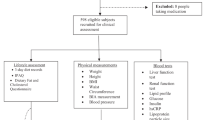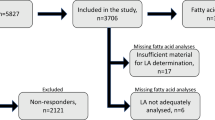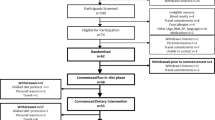Abstract
Background/objectives:
Small dense low-density lipoprotein (LDL) particles and apolipoprotein (apo) CIII are risk factors for cardiovascular disease (CVD) that can be modulated by diet, but there is little information regarding the effects of dietary saturated fat on their plasma levels. We tested the effects of high vs low saturated fat intake in the context of a high beef protein diet on levels and composition of LDL subclasses and on apoCIII levels in plasma and LDL.
Subjects/methods:
Following consumption of a baseline diet (50% carbohydrate (CHO), 13% protein, 38% total fat, 15% saturated fat) for 3 weeks, 14 healthy men were randomly assigned to two reduced CHO high beef protein diets (31% CHO, 31% protein, 38% fat) that differed in saturated fat content (15% vs 8%) for 3 weeks each in a crossover design.
Results:
The high saturated fat (HSF) diet resulted in higher mass concentrations of buoyant LDL I, medium density LDL II and dense LDL III, but not the very dense LDL IV; and significant increases in plasma and LDL apoCIII concentration of 9.4% and 33.5%, respectively. The saturated fat-induced changes in LDL apoCIII were specifically correlated with changes in apoCIII content of LDL IV.
Conclusions:
Taken together with previous observations, these findings suggest that, at least in the context of a lower CHO high beef protein diet, HSF intake may increase CVD risk by metabolic processes that involve apoCIII.
This is a preview of subscription content, access via your institution
Access options
Subscribe to this journal
Receive 12 print issues and online access
$259.00 per year
only $21.58 per issue
Buy this article
- Purchase on Springer Link
- Instant access to full article PDF
Prices may be subject to local taxes which are calculated during checkout

Similar content being viewed by others
References
Denke MA . Dietary fats, fatty acids, and their effects on lipoproteins. Curr Atheroscler Rep 2006; 8: 466–471.
Krauss RM . Lipoprotein subfractions and cardiovascular disease risk. Curr Opin Lipidol 2010; 21: 305–311.
Mora S, Szklo M, Otvos JD, Greenland P, Psaty BM, Goff DC et al. LDL particle subclasses, LDL particle size, and carotid atherosclerosis in the Multi-Ethnic Study of Atherosclerosis (MESA). Atherosclerosis 2007; 192: 211–217.
St-Pierre AC, Cantin B, Dagenais GR, Mauriege P, Bernard PM, Despres JP et al. Low-density lipoprotein subfractions and the long-term risk of ischemic heart disease in men: 13-year follow-up data from the Quebec Cardiovascular Study. Arterioscler Thromb Vasc Biol 2005; 25: 553–559.
Musunuru K, Orho-Melander M, Caulfield MP, Li S, Salameh WA, Reitz RE et al. Ion mobility analysis of lipoprotein subfractions identifies three independent axes of cardiovascular risk. Arterioscler Thromb Vasc Biol 2009; 29: 1975–1980.
Berneis KK, Krauss RM . Metabolic origins and clinical significance of LDL heterogeneity. J Lipid Res 2002; 43: 1363–1379.
Williams PT, Superko HR, Haskell WL, Alderman EL, Blanche PJ, Holl LG et al. Smallest LDL particles are most strongly related to coronary disease progression in men. Arterioscler Thromb Vasc Biol 2003; 23: 314–321.
Musunuru K, Strong A, Frank-Kamenetsky M, Lee NE, Ahfeldt T, Sachs KV et al. From noncoding variant to phenotype via SORT1 at the 1p13 cholesterol locus. Nature 2010; 466: 714–719.
Dreon DM, Fernstrom HA, Campos H, Blanche P, Williams PT, Krauss RM . Change in dietary saturated fat intake is correlated with change in mass of large low-density-lipoprotein particles in men. Am J Clin Nutr 1998; 67: 828–836.
Krauss RM, Blanche PJ, Rawlings RS, Fernstrom HS, Williams PT . Separate effects of reduced carbohydrate intake and weight loss on atherogenic dyslipidemia. Am J Clin Nutr 2006; 83: 1025–1031.
Mangravite LM, Chiu S, Wojnoonski K, Rawlings RS, Bergeron N, Krauss RM . Changes in atherogenic dyslipidemia induced by carbohydrate restriction in men are dependent on dietary protein source. J Nutr 2011; 141: 2180–2185.
Clavey V, Lestavel-Delattre S, Copin C, Bard JM, Fruchart JC . Modulation of lipoprotein B binding to the LDL receptor by exogenous lipids and apolipoproteins CI, CII, CIII, and E. Arterioscler Thromb Vasc Biol 1995; 15: 963–971.
Wang CS, McConathy WJ, Kloer HU, Alaupovic P . Modulation of lipoprotein lipase activity by apolipoproteins. Effect of apolipoprotein C-III. J Clin Invest 1985; 75: 384–390.
Sacks FM, Alaupovic P, Moye LA, Cole TG, Sussex B, Stampfer MJ et al. VLDL, apolipoproteins B, CIII, and E, and risk of recurrent coronary events in the Cholesterol and Recurrent Events (CARE) trial. Circulation 2000; 102: 1886–1892.
Gervaise N, Garrigue MA, Lasfargues G, Lecomte P . Triglycerides, apo C3 and Lp B:C3 and cardiovascular risk in type II diabetes. Diabetologia 2000; 43: 703–708.
Chivot L, Mainard F, Bigot E, Bard JM, Auget JL, Madec Y et al. Logistic discriminant analysis of lipids and apolipoproteins in a population of coronary bypass patients and the significance of apolipoproteins C-III and E. Atherosclerosis 1990; 82: 205–211.
Alaupovic P, Mack WJ, Knight-Gibson C, Hodis HN . The role of triglyceride-rich lipoprotein families in the progression of atherosclerotic lesions as determined by sequential coronary angiography from a controlled clinical trial. Arterioscler Thromb Vasc Biol 1997; 17: 715–722.
Lee SJ, Campos H, Moye LA, Sacks FM . LDL containing apolipoprotein CIII is an independent risk factor for coronary events in diabetic patients. Arterioscler Thromb Vasc Biol 2003; 23: 853–858.
Kawakami A, Aikawa M, Libby P, Alcaide P, Luscinskas FW, Sacks FM et al. in apolipoprotein B lipoproteins enhances the adhesion of human monocytic cells to endothelial cells. Circulation 2006; 113: 691–700.
Kawakami A, Aikawa M, Nitta N, Yoshida M, Libby P, Sacks FM . Apolipoprotein CIIi-induced THP-1 cell adhesion to endothelial cells involves pertussis toxin-sensitive G protein- and protein kinase C alpha-mediated nuclear factor-kappaB activation. Arterioscler Thromb Vasc Biol 2007; 27: 219–225.
Kawakami A, Aikawa M, Alcaide P, Luscinskas FW, Libby P, Sacks FM et al. induces expression of vascular cell adhesion molecule-1 in vascular endothelial cells and increases adhesion of monocytic cells. Circulation 2006; 114: 681–687.
Choi SY, Komaromy MC, Chen J, Fong LG, Cooper AD . Acceleration of uptake of LDL but not chylomicrons or chylomicron remnants by cells that secrete apoE and hepatic lipase. J Lipid Res 1994; 35: 848–859.
Pitas RE, Innerarity TL, Mahley RW . Cell surface receptor binding of phospholipid. protein complexes containing different ratios of receptor-active and -inactive E apoprotein. J Biol Chem 1980; 255: 5454–5460.
Warnick GR, Nguyen T, Albers AA . Comparison of improved precipitation methods for quantification of high-density lipoprotein cholesterol. Clin Chem 1985; 31: 217–222.
Friedewald WT, Levy RI, Fredrickson DS . Estimation of the concentration of low-density lipoprotein cholesterol in plasma, without use of the preparative ultracentrifuge. Clin Chem 1972; 18: 499–502.
Matthews DR, Hosker JP, Rudenski AS, Naylor BA, Treacher DF, Turner RC . Homeostasis model assessment: insulin resistance and beta-cell function from fasting plasma glucose and insulin concentrations in man. Diabetologia 1985; 28: 412–419.
Shen MM, Krauss RM, Lindgren FT, Forte TM . Heterogeneity of serum low density lipoproteins in normal human subjects. J Lipid Res 1981; 22: 236–244.
Markwell MA, Haas SM, Bieber LL, Tolbert NE . A modification of the Lowry procedure to simplify protein determination in membrane and lipoprotein samples. Anal Biochem 1978; 87: 206–210.
La Belle M, Blanche PJ, Krauss RM . Charge properties of low density lipoprotein subclasses. J Lipid Res 1997; 38: 690–700.
Lee DM, Alaupovic P, Apolipoproteins B . C-III and E in two major subpopulations of low-density lipoproteins. Biochim Biophys Acta 1986; 879: 126–133.
Davidsson P, Hulthe J, Fagerberg B, Olsson BM, Hallberg C, Dahllof B et al. A proteomic study of the apolipoproteins in LDL subclasses in patients with the metabolic syndrome and type 2 diabetes. J Lipid Res 2005; 46: 1999–2006.
Mendivil CO, Rimm EB, Furtado J, Chiuve SE, Sacks FM . Low-density lipoproteins containing apolipoprotein C-III and the risk of coronary heart disease. Circulation 2011; 124: 2065–2072.
Kawakami A, Yoshida M . Apolipoprotein CIII links dyslipidemia with atherosclerosis. J Atheroscler Thromb 2009; 16: 6–11.
Archer WR, Desroches S, Lamarche B, Deriaz O, Landry N, Fontaine-Bisson B et al. Variations in plasma apolipoprotein C-III levels are strong correlates of the triglyceride response to a high-monounsaturated fatty acid diet and a high-carbohydrate diet. Metabolism 2005; 54: 1390–1397.
Desroches S, Ruel IL, Deshaies Y, Paradis ME, Archer WR, Couture P et al. Kinetics of plasma apolipoprotein C-III as a determinant of diet-induced changes in plasma triglyceride levels. Eur J Clin Nutr 2008; 62: 10–17.
Shin MJ, Blanche PJ, Rawlings RS, Fernstrom HS, Krauss RM . Increased plasma concentrations of lipoprotein(a) during a low-fat, high-carbohydrate diet are associated with increased plasma concentrations of apolipoprotein C-III bound to apolipoprotein B-containing lipoproteins. Am J Clin Nutr 2007; 85: 1527–1532.
Furtado JD, Campos H, Appel LJ, Miller ER, Laranjo N, Carey VJ et al. Effect of protein, unsaturated fat, and carbohydrate intakes on plasma apolipoprotein B and VLDL and LDL containing apolipoprotein C-III: results from the OmniHeart Trial. Am J Clin Nutr 2008; 87: 1623–1630.
Brousseau ME, Ordovas JM, Osada J, Fasulo J, Robins SJ, Nicolosi RJ et al. Dietary monounsaturated and polyunsaturated fatty acids are comparable in their effects on hepatic apolipoprotein mRNA abundance and liver lipid concentrations when substituted for saturated fatty acids in cynomolgus monkeys. J Nutr 1995; 125: 425–436.
Olin-Lewis K, Krauss RM, La Belle M, Blanche PJ, Barrett PH, Wight TN et al. ApoC-III content of apoB-containing lipoproteins is associated with binding to the vascular proteoglycan biglycan. J Lipid Res 2002; 43: 1969–1977.
Shin MJ, Krauss RM . Apolipoprotein CIII bound to apoB-containing lipoproteins is associated with small, dense LDL independent of plasma triglyceride levels in healthy men. Atherosclerosis 2010; 211: 337–341.
Mendivil CO, Zheng C, Furtado J, Lel J, Sacks FM . Metabolism of very-low-density lipoprotein and low-density lipoprotein containing apolipoprotein C-III and not other small apolipoproteins. Arterioscler Thromb Vasc Biol 2010; 30: 239–245.
Acknowledgements
This study was supported by the Beef Checkoff, through the National Cattlemen’s Beef Association and in part by NIH/NCRR UCSF-CTSI grant number UL1 RR024131. We thank the study participants and Robin S Rawlings for subject recruitment and clinical assistance; Casey Geaney, Vanessa Kreger, Joe Orr, Jeff Payumo, Bahareh Sahami and Katie Wojnoonski for laboratory support; and Harriett S Fernstrom and Cewin Chao for assistance in the dietary intervention.
Author information
Authors and Affiliations
Corresponding author
Ethics declarations
Competing interests
The authors declare no conflict of interest.
Rights and permissions
About this article
Cite this article
Faghihnia, N., Mangravite, L., Chiu, S. et al. Effects of dietary saturated fat on LDL subclasses and apolipoprotein CIII in men. Eur J Clin Nutr 66, 1229–1233 (2012). https://doi.org/10.1038/ejcn.2012.118
Received:
Revised:
Accepted:
Published:
Issue Date:
DOI: https://doi.org/10.1038/ejcn.2012.118
Keywords
This article is cited by
-
Liver saturated fat content associates with hepatic DNA methylation in obese individuals
Clinical Epigenetics (2023)
-
Metabolism of triglyceride-rich lipoproteins in health and dyslipidaemia
Nature Reviews Cardiology (2022)
-
Saturated Fat and Cardiovascular Health: Phenotype and Dietary Factors Influencing Interindividual Responsiveness
Current Atherosclerosis Reports (2022)
-
The effects of fat consumption on low-density lipoprotein particle size in healthy individuals: a narrative review
Lipids in Health and Disease (2021)
-
ANGPTL3 and Apolipoprotein C-III as Novel Lipid-Lowering Targets
Current Atherosclerosis Reports (2021)



